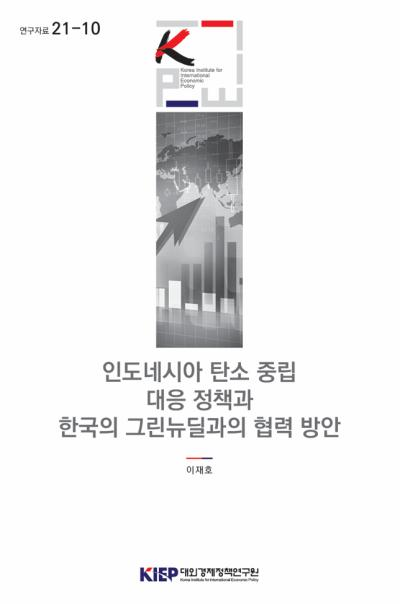World Economy Brief
Publications
World Economy Brief
To list

Analysis on Net-Zero Policy of Indonesia and It’s Implication for Korean Green New Deal Policy
energy industry, environmental policy
Author Jaeho Lee Series 21-10 Language Korean Date 2022.03.30
While the international community has been engaged in dialogue on countermeasures to climate change by global warming, Indonesia, which ranked 8th in the world in Co2 emissions and top in ASEAN, has submitted its nationally determined contribution (NDC) targets of unconditional reduction of 29% and conditional reduction of 41% by 2030, and announced the net zero target by 2060. Indonesia is a core partner of Korea’s New Southern Policy and has been identified as a promising market for micro-grid projects in the K-New Deal Globalization Strategy, but as of yet no comprehensive strategy has been established that takes into account Indonesia’s net zero policy. To address this gap, this paper examines and suggests policy directions for cooperation with Korea’s Green New Deal, based on an analysis of Indonesian policies related to carbon neutrality and the current status of international cooperation in Indonesia.
Indonesia had submitted a NDC target of unconditional reduction of 29%, conditional reduction of 41% by 2030, and has been implementing a series of policies in various areas, for example finance, technical assistance, capacity building, etc. Indonesia is coordinating its NDC targets and the local adaption and mitigation policies through the Long-Term Strategy for Low Carbon and Climate Resilience (LTS-CCR) 2050. In addition, a series of policies in the areas of environment protection, renewable energy, reforestation, and waste management had been introduced in the National Medium Term Development Plan (RPJMN) for 2020-2024. The National Energy Policy(KEN), which is the major initiative for Co2 emission mitigation, pursues to change the energy consumption structure by increasing the share of renewable energy instead of fossil fuels. The National Energy Plan(RUEN) is a set of multi-sectoral policies to implement the targets of KEN. The National Electricity Plan(RUKN) is the core plan of RUEN, in line with which the country has been implementing the structural change of national electricity generation by increasing the share of renewable energy(12%→28%) and decreasing the share of fossil fuels(60%→47%).
Indonesia has been implementing various forms of multilateral and bilateral international cooperation to respond to climate change. Multilateral cooperation through the UNFCCC(UN Framework Convention on Climate Change) has been supported by major climate funds, such as the Global Environment Fund(GEF) and Green Climate Fund(GCF), while sectoral funds like the FCPF(Forest Carbon Partnership Facility), CIF(Climate Investment Fund) are supported by multilateral development banks. In this study, bilateral cooperation is analyzed using the Creditor Reporting System (CRS) ODA data of the OECD DAC. Japan took the top rank of major donors with a share of 53.6%, followed by France(14.9%), Germany(14.5%), the US(5.1%), and Australia(3.7%). The energy sector took the biggest share of 36.7%, followed by environment protection (21.3%), transport & storage(20.6%), agriculture & fishery(8.1%), etc. Physical infrastructure projects accounted for a major share of support from Japan and Germany, and administration and environment protection took the biggest share of support from France and the US. Support from Australia is relatively small in size, but covers various fields. In the case of Korea, Indonesia took the largest share of 77% of all its overseas afforestation activities, but did not produce recognizable mitigation achievements. Korea and Indonesia have been holding regular bilateral forums in the area of energy, and during the 12th forum held in 2021 the two countries focused on cooperation in the areas of renewable energy.
In order to establish a policy toward achieving net-zero targets with Indonesia, Korea needs to prepare a cooperative approach based on analysis of Co2 emission status, net-zero policies, and international cooperation, etc. When considering the Land Use Change and Forestry(LUCF) accounted for the largest share (43.59%) of the total Co2 Emission in Indonesia, Korea needs to establish cooperation plans for the LUCF sector, such as the Reducing Emissions from Deforestation and Forest Degradation Plus (REDD+). In addition to bilateral cooperation in the REDD+, private-public cooperative platforms such as Lowering Emissions by Accelerating Forest Finance (LEAF) could provide further positive approaches for multilateral cooperation. Other multilateral cooperative mechanisms such as the ASEAN+3 or EAS would also be good channels for REDD+ cooperation. In the energy sector, emissions from electricity generation took the largest share (35%) in Indonesia, and the demand to develop renewable energy has been increasing for the energy mix conversion in the electricity generation sector. Considering the high demand for cooperation in renewable energy, the first step for energy cooperation between Korea and Indonesia would be solar and hydro generation. In addition to the electricity generation sector, the upstream and downstream linkage in the supply chain would create a synergy effect. To promote this synergy, developers should utilize financial linkages based on the basic characteristics of each project. Entering into PPP or purchasing contracts with local partners like power companies or institutions would be a positive approach to secure stable profitability. In transport sector, Korea and Indonesia have agreed to implement an EDCF project titled “EV infrastructure development project in Jakarta” from 2023. Korea also needs to expand the field of cooperation from physical infrastructure to the software and institutions to lead the EV ecosystem in Jakarta.
Sales Info
| Quantity/Size | 110 |
|---|---|
| Sale Price | 7 $ |
 공공저작물 자유이용허락 표시기준 (공공누리, KOGL) 제4유형
공공저작물 자유이용허락 표시기준 (공공누리, KOGL) 제4유형
대외경제정책연구원의 본 공공저작물은 "공공누리 제4유형 : 출처표시 + 상업적 금지 + 변경금지” 조건에 따라 이용할 수 있습니다. 저작권정책 참조
